I recently visited a friend who has just finished renovating their home. As part of this, they installed barn doors between several of their interior rooms. However, after installation, they noticed that the doors can let quite a bit of sound through.
Because they knew about my experience with soundproofing, they asked me, how do I soundproof a barn door? I thought of some solutions off the top of my head, but figured I’d do a bit more research.
The result is this article, where I cover how to soundproof a barn door. I’ll cover 10 methods that address different aspects and budgets, along with some of the limitations of hanging slide doors.
10 Ways to Soundproof a Barn Door
For each of the solutions below, I’ve included some ratings to help you decide which will be most suitable. They cover budget, effectiveness and difficulty, so it should be a fairly clear decision.
My tips below primarily address airborne noise rather than impact noise. I explain the difference in my article on sound absorption vs. soundproofing, so I recommend checking that out for an explanation.
1. Add Weatherstripping or Foam Tape to the Side
If you’re not familiar with it, weatherstripping is a self-adhesive foam tape that you use to seal gaps around doors and windows. It’s typically meant for thermal insulation, but acoustic insulation follows many of the same principles.
Weatherstripping comes in different thicknesses, such as quarter-inch or 1 inch. The first step, therefore, will be to measure the gap between the door and the wall. You’ll need this measurement to determine what gauge tape you buy, and how much.
I’m generally a fan of foam tape for low-budget quick-fixes, as it helps absorb airborne sound, which is the main issue with large gaps around the door. It does so in the same way as acoustic foam panels or fiberglass insulation: it causes sound waves to expend energy as they pass through the material.
To install foam weatherstripping, do the following:
- Measure the door’s dimensions. You’ll need to know how long each side is, and the width of the gap between the door and wall.
- Weatherstripping has adhesive backing that you peel off to stick it down. I recommend applying it to the door, as it’ll be less obvious.
- To do this, you might need to take the door off its rail if it’s not too heavy.
- If you’ve got space and you don’t mind how it looks, applying a second layer to the wall will create a good seal between the 2 layers of tape.
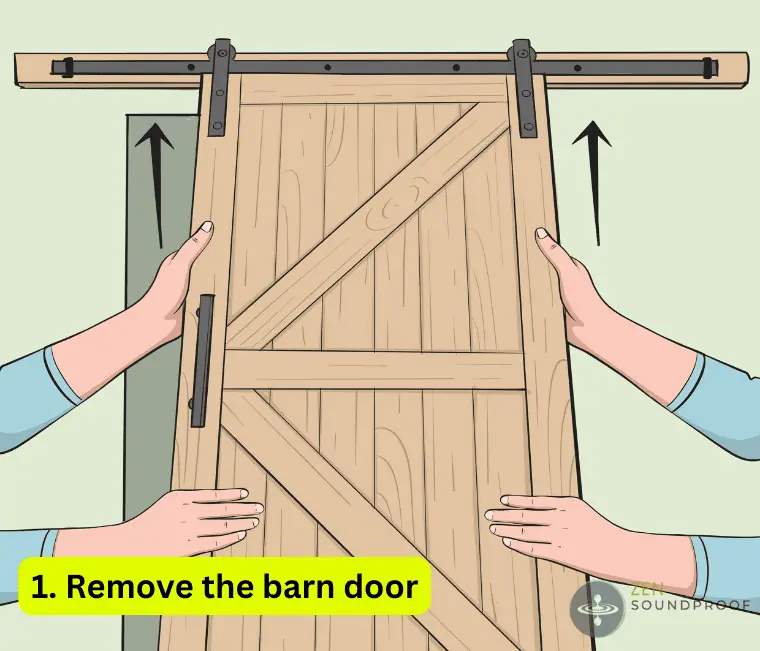
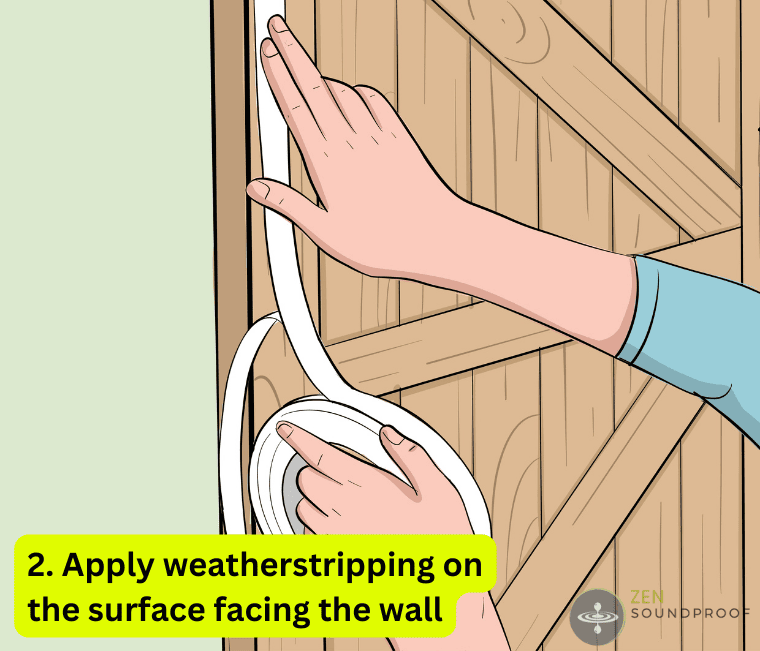
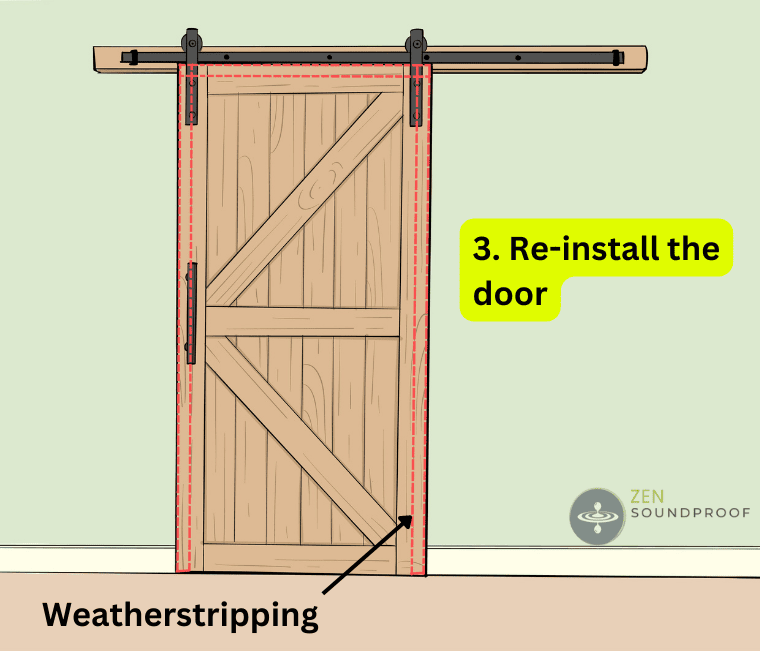
Weatherstripping is one of the better options for closing the gap between the wall and the door. It’s an absorptive material, meaning it helps to reduce airborne noise transmission. I recommend it for numerous other soundproofing projects, too.
2. Add a Door Sweep, Draft Stopper or Board to the Bottom
The gap at the bottom of a door is one of the worst areas for sound transmission. This is true of any type of door and is an area we need to address on barn doors. As mentioned above, acoustic insulation follows many of the same principles as thermal insulation, meaning we have plenty of options for this issue.
One big difference with barn doors, though, is that you’ll only be able to apply a draft stopper to one side. Whereas a swing door has room on either side, a barn door slides open against a wall. It’s unlikely you’ll be able to fit a draft stopper on the wall-facing side.
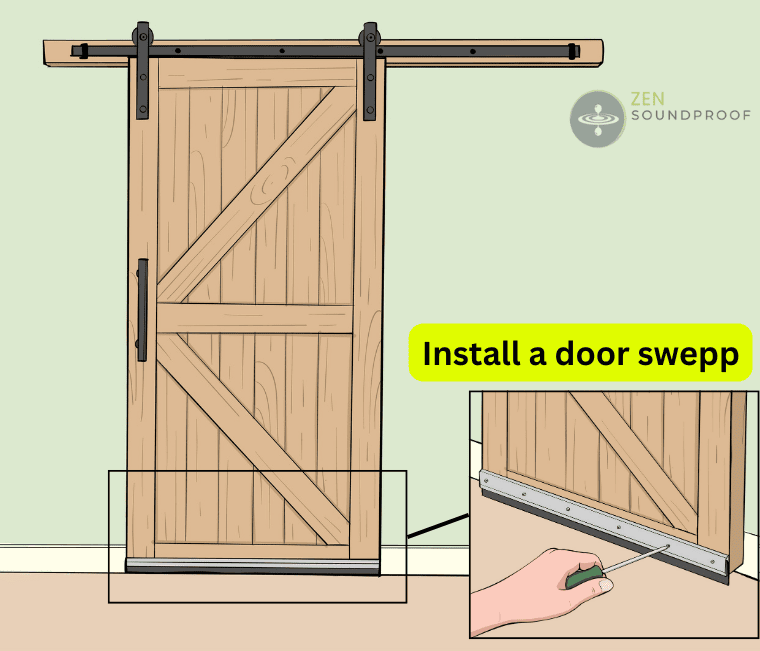
As such, you’ll need a draft stopper. Alternatively, you could use a door sweep, which is more rigid than a draft stopper. Finally, you could use a piece of plywood or MDF, although this won’t necessarily be a cheaper solution and risk scratching your flooring.
I find there are 2 main drawbacks with door sweeps that make them unsuitable to soundproof barn doors. The first is that they’re not particularly effective for soundproofing. I explain this in more detail in my article on the best soundproofing door sweeps. But the bottom line is that they’re not dense enough to add much value.
The other issue is that most door sweeps require installation, specifically with screws. This means they’re not a suitable option for renters. Draft stoppers often have adhesive backing, so I recommend looking at these instead.
3. Improve the Door Guide: Rail and Rollers
One of the main selling points of barn doors is that they slide on rails or rollers. This can help from a space-saving perspective but it leads to the issue of large air gaps, which is what we’re trying to solve.
Equally, poorly installed door guides can result in wobbly doors or larger gaps between the wall and the door. A wobbly door will make more noise as it opens and shuts, and larger air gaps mean more sound transmission.
We can attempt to solve these problems by adjusting or replacing the rail. Unsurprisingly, this means a bit of DIY work. There are a few solutions I know of that can solve this issue:
- Add a guide rail at the bottom. This’ll prevent wobble by making the door more secure on its railings. Of course, this could become a trip hazard.
- Replace the roller rail. If the top rail is old or too big, the door will wobble more. Replace it with a new one that’s the correct size to keep the door steadier.
- Install a smaller rail. While not always possible, installing a smaller rail will keep the door closer to the wall. This’ll reduce the air gap, which you could then seal with weatherstripping.
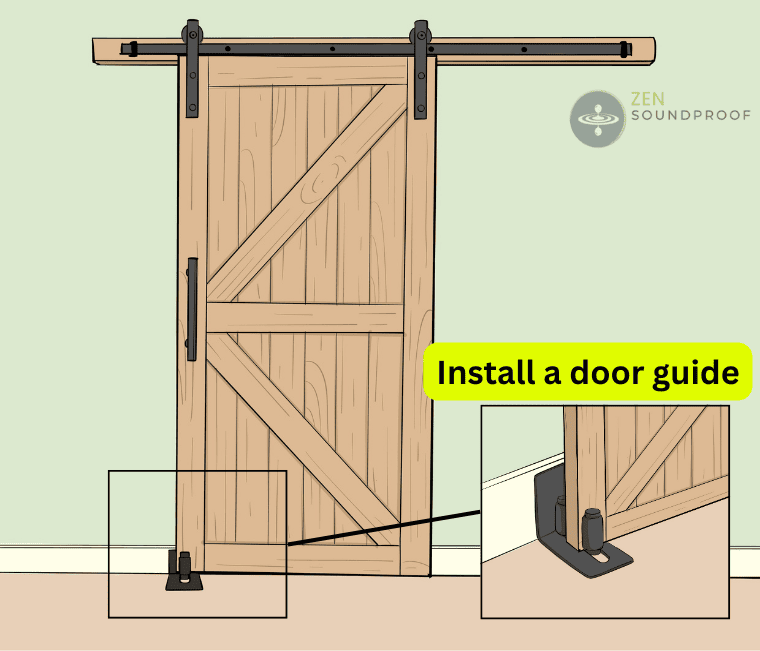
A barn door should be able to move freely on its rail without any wobble. If you’re unsure what rail you’d need to install to solve this problem, consider speaking to a professional.
I recommend combining this tip with some soundproofing materials. Reducing wobble will obviously help, but it won’t address air gaps in the right way. As such, I think it’s worth adding materials such as weatherstripping or blankets too.
4. Hang Soundproof Blankets Over the Door
Soundproof blankets are heavy and dense fabrics that can help absorb and dampen sound waves. One of the main benefits for using them with doors is that they’re removable and so provide a good compromise between effectiveness and installation.
Of course, the amount of sound they absorb and dampen ultimately depends on the fabric you use. Soundproof blankets are often heavier than curtains but are harder to install over doors.
I’ve got separate articles on the best soundproof blankets. Check them out for some product recommendations for this tip.
Installation will vary depending on what you’re using, but blankets with grommets can be hung from hooks. Fit these above the door and then hang the blanket when the door is shut. Blankets without grommets could be fixed to the door with adhesive or nails or draped over the top if the gap is big enough.
You could install soundproof blankets in front or behind the door, or after the threshold. I recommend installing the blanket inside the room (in front of the door). Also, make sure your blanket or curtain is several inches wider than the door. This helps to create a better “seal” to reduce sound transmission.
There are numerous products available, but the most common will be heavy fabric. Velvet is a common option, or you can get dedicated soundproofing materials like the Audimute Dampening Blanket.
I won’t cover the pros and cons of specific materials because you can find that information in my articles above. The bottom line is that you want the heaviest and densest materials you can safely hang in front of the door.
5. Use Soundproof Curtains as a Door Cover
Similarly to the tip above, you could use soundproof curtains instead. I have a dedicated article discussing soundproof curtains in more depth, so I recommend reading through that before settling on this option.
You can install curtains in the same locations as blankets, but the installation method will be different. Curtains will need to be hung from a curtain rail, which does make it easier. Unlike with swing doors, both curtains and barn doors slide, so they won’t get in each other’s way.
However, I’m not really a fan of soundproof curtains. They typically don’t have enough mass to block sound, and there are far better absorptive materials (blankets, foam, etc.). But if looks are important to you, they’ll be a better option than soundproof blankets. Just bear in mind you won’t get the same kind of noise reduction.
6. Install a Larger Door
There’s not much to this tip. Installing a larger door covers more of the wall and helps to reduce the gaps that sound passes through.
I recommend combining this with other tips, though, as a larger door alone won’t address all the problem areas. As I mentioned in the door rail tip, this is more about improving the basic hardware, onto which you can install some noise-reducing materials.
7. Add a Layer to the Existing Door
Increasing the door’s mass is an effective way of reducing sound transmission through the door itself. If your barn door is already solid, this might not be necessary, as some can weigh a few hundred pounds!
Ideally, you’ll want to use the heaviest material you can safely install on the door. Mass loaded vinyl is an effective (but ugly) option. You could add a layer of wood, provided you choose something suitably thick and dense.
Make sure you add a layer of Green Glue Noiseproofing Compound between the layers for extra sound dampening.
I’m a big fan of mass loaded vinyl for solutions like this because it’s specifically designed for soundproofing projects. While it looks expensive, its cost-benefit ratio is better than, say, drywall or soundproof curtains. Bear in mind it looks pretty ugly, so you’ll want to try covering it with something nicer, such as a layer of wood.
8. Install a Solid Door
This is another straightforward tip. If your barn door is hollow (as many interior doors are), consider replacing it with a solid one. Hollow core barn doors allow more sound to pass through, simply because they have less mass.
If possible, look for a dense, solid wood, such as oak, maple, hickory, etc. Avoid pine because it’s a fairly lightweight wood. Solid core barn doors made of dense woods will be heavier, and will help block more noise.
Check out this video for a guide on how to replace a barn door.
9. Install a Second Door Behind the Barn Door
This tip works on similar logic to the one above: we’re adding more mass to the door passageway itself to reduce sound transmission. However, adding a second door also creates an air gap between the two, which acts as a sound barrier.
It works on the soundproofing principle of decoupling. While you could install any door type you want, it probably makes sense to add a second barn door to maintain the aesthetic.
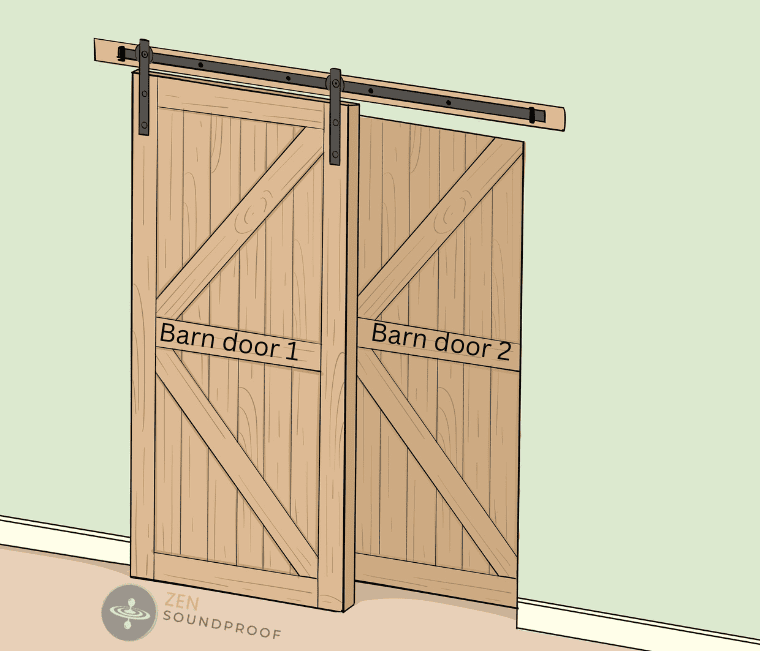
10. Hire a Carpenter
If you’re not too DIY-savvy, or you’re not sure what you’re looking for, consider speaking to a professional carpenter to see what they can do. First, they’ll be able to check the door’s installation and replace the rail if necessary.
You could also ask them to add more weight to the door with crafty bits of wood. Similarly, they might be able to reduce the gap around the door with lumber.
While I enjoy solving a project myself, I also appreciate that sometimes the best option is to call in an expert! If you explain your needs (and use some of the information you’ve learnt here), you should be able to come up with a decent solution together.
Key Considerations for Soundproofing Sliding Barn Doors
The main consideration when soundproofing barn doors is knowing what type of door you have. This is because the space they need to open – and how many doors there are – will impact the options you have.
We have 5 main types of barn door:
- Single barn doors. They slide on a track above the door frame.
- Double barn doors. There are 2 doors that slide from opposite sides and meet in the middle.
- Bypass barn doors. These consist of 2 or more doors that can slide past each other because they’re on separate tracks.
- Bi-parting barn doors. These are basically double doors but larger.
- Mini barn doors. These are normal barn doors, but small. While we wouldn’t typically soundproof them, any of the methods above would apply.
Single barn doors are probably the easiest to soundproof because you can apply materials to the door and the wall gaps. Double doors, however, are more challenging. Creating a tight seal between the doors is almost impossible and will always be pretty obvious.
Common Challenges When Soundproofing a Sliding Barn Door
Soundproofing sliding doors comes with a few challenges. These are:
- Reducing sound transmission while retaining the door’s appearance.
- Working with low-quality or ineffective hardware. For example, a cheap or bent roller, hollow core door, etc.
- Finding the right materials to block air gaps while allowing the door to function. An example I’ve mentioned above is finding weatherstripping with the correct width to fit in the gap, but door sweeps might have the same issue.
- Dealing with rental restrictions (not being able to make permanent changes). These can range from not being able to drill holes for blanket hanging hooks to screwing extra panels to the doors. You might also not be able to change the door or its rail without permission.
However, the solutions I’ve given above should address these challenges. Ideally, I recommend combining hardware upgrades (solid core barn door, better/more rails) with some soundproofing materials. Although soundproofing materials will help, it’ll be best to fit them onto a high-quality base structure.
Are Barn Doors Soundproof?
Doors are always the weakest area of a room due to their very nature. This is only made worse when you have a sliding door that’s almost completely separate from the wall. As such, you’ll be able to reduce sound transmission but never fully make barn doors soundproof.
Final Thoughts
I hope at least one of the tips above will help you soundproof your barn door. I recommend you start by measuring the gaps and then considering your budget and ability to make changes. Knowing this information should help you decide which options will be most suitable.
Have you tried soundproofing a barn door before? If so, I’d love to hear your thoughts and what solutions you tried.
